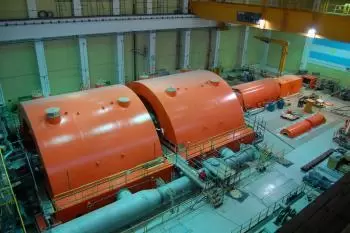
An electrical generator is a machine capable of transforming some type of energy into an electric current. The energy source can be very varied: chemical energy, mechanical energy, light energy or thermal energy.
Mechanisms that perform this energy conversion can include steam turbines, gas turbines, water turbines, internal combustion engines, and even cranks.
Electric generators are electrical devices capable of maintaining a difference in electrical potential (voltage) between two points. That is, devices that produce electrical energy.
The first electromagnetic generator, the Faraday disk, was invented in 1831 by British scientist Michael Faraday. Generators provide almost all the power for electrical grids.
Today, it is possible to buy an electric generator for almost any need.
Types of electric generators
There are various types of electric generators, each with its own characteristics:
-
Mechanical generators: They use mechanical energy to generate electricity, their application being common in industry. They stand out for their efficiency and diversity, including diesel and gasoline generators.
-
Solar generators: They transform solar energy into electricity through photovoltaic panels, generating direct current.
-
Thermal generators: They convert thermal energy into electricity.
-
Chemical generators: They convert chemical energy into electricity, batteries being an example.
Mechanical electric generator
They operate under the principle of electromagnetic induction, where a magnetic field acts on electrical conductors arranged in coils. The relative motion between the conductors and the field generates an electromotive force, discovered by Michael Faraday. These generators range in size from small diesels to industrial machines, often equipped with electric start. Mechanical energy is obtained through thermal engines, such as gasoline or diesel engines, used in both thermoelectric and nuclear power plants.
In the case of dynamos, the electromagnetic principle is used to convert mechanical rotation into alternating current, being a fundamental device since its invention in 1832 by Hippolytus Pixie.
Thermoelectric generators (TEG)
These devices convert the temperature difference directly into electricity through the Seebeck effect. Although they do not have moving parts, their efficiency is low and the cost is high. Its application is expected in the automotive industry, taking advantage of exhaust heat. They can work in conjunction with photovoltaics to increase efficiency.
Radioisotope Thermoelectric Generator (RTG)
Used in spacecraft, it converts the energy released by the radioactive decay of elements into electricity. Suitable for situations without human presence and where sustained power is required for long periods, being an alternative in environments where photovoltaic cells are not viable.
Solar generators (photovoltaic)
They work through the photovoltaic effect, where photovoltaic panels release electrons upon impact with a photon, generating direct electric current. Silicon is the material commonly used in these cells.
Examples of uses and applications
Below we show several example applications using electricity generators:
Electric power plant
A power plant is defined as an industrial facility dedicated to the generation of electricity through the use of mechanical generators. Electric current is generated through the relative movement between a magnetic flux and a conductor.
Energy in power plants is obtained through various sources, such as:
- Fossil Fuels: Predominant in most power plants around the world.
- Nuclear Reactions: Used in nuclear power plants.
- Renewable Energies: Including solar, wind and hydroelectric.
Vehicle generators
Generators play a crucial role in propulsion of various forms of transportation:
- Road Vehicles: They require electrical energy to power the instrumentation, keep the engine running and recharge the batteries.
- Sailboats: They can use water or wind generators to charge the batteries using small propellers, wind turbines or thrusters, supplying current at typical wind or cruising speeds.
- Electric Scooters: Electric scooters with regenerative braking have gained global popularity.
Generator sets
A motor-generator is formed by combining an electric generator and a motor, forming an autonomous unit. Reciprocating piston engines are often used, although there are also variants that use gas turbines.
Electricity generators in nuclear power plants
Electrical generators in nuclear power plants are mainly of the synchronous type, producing alternating current synchronized with the frequency of the electrical grid.
Equipped with stator coils and rotors, these generators use advanced cooling systems, such as hydrogen coolant, to maintain safe temperatures. With significant load capacity, they have sophisticated control systems to regulate power output according to electrical demands.
In addition, they also have emergency backup, such as diesel engines, to ensure continuous generation even in critical situations.